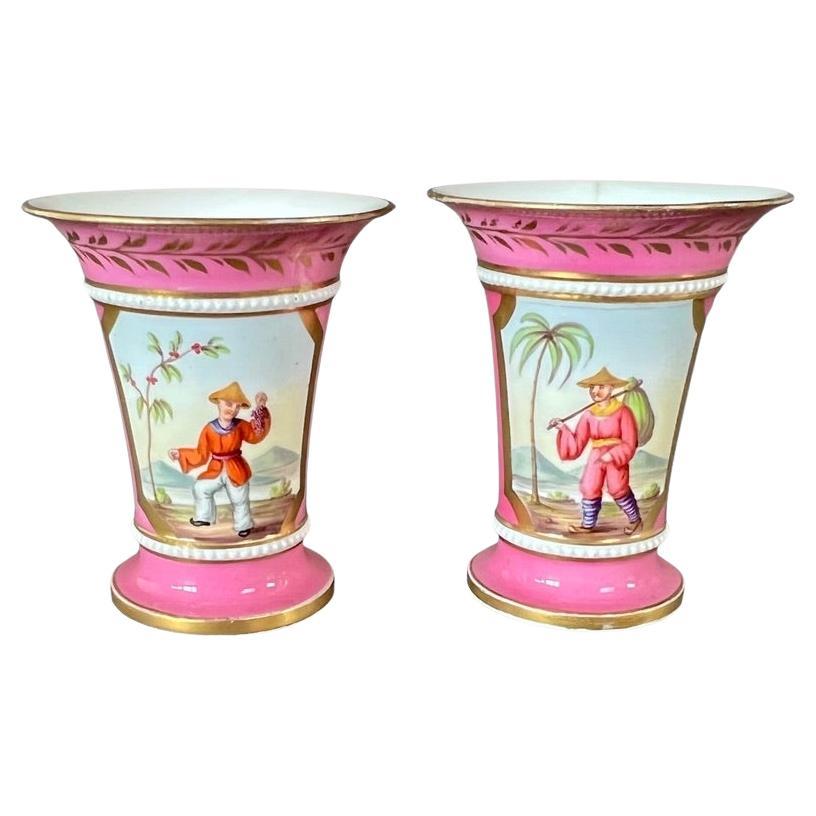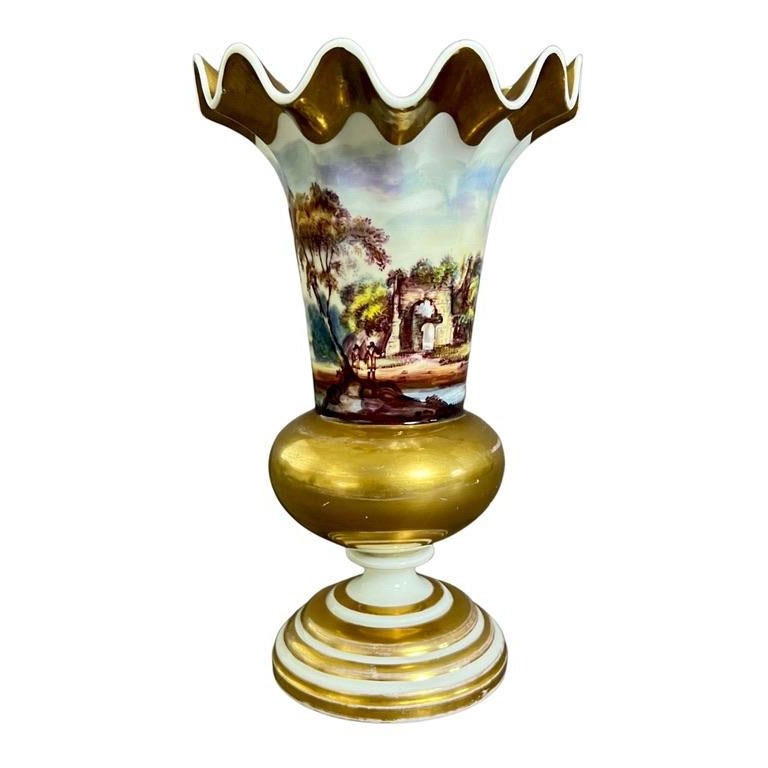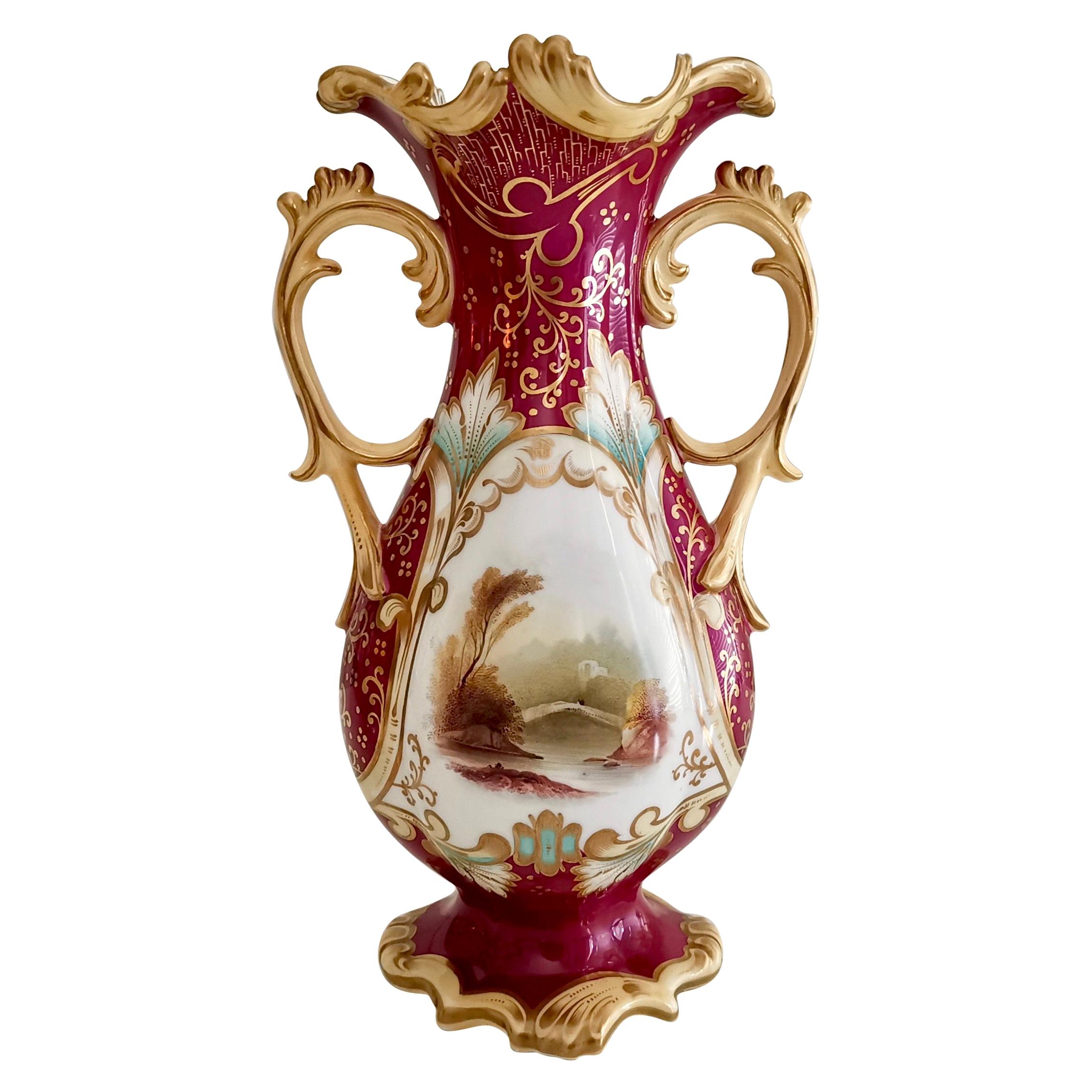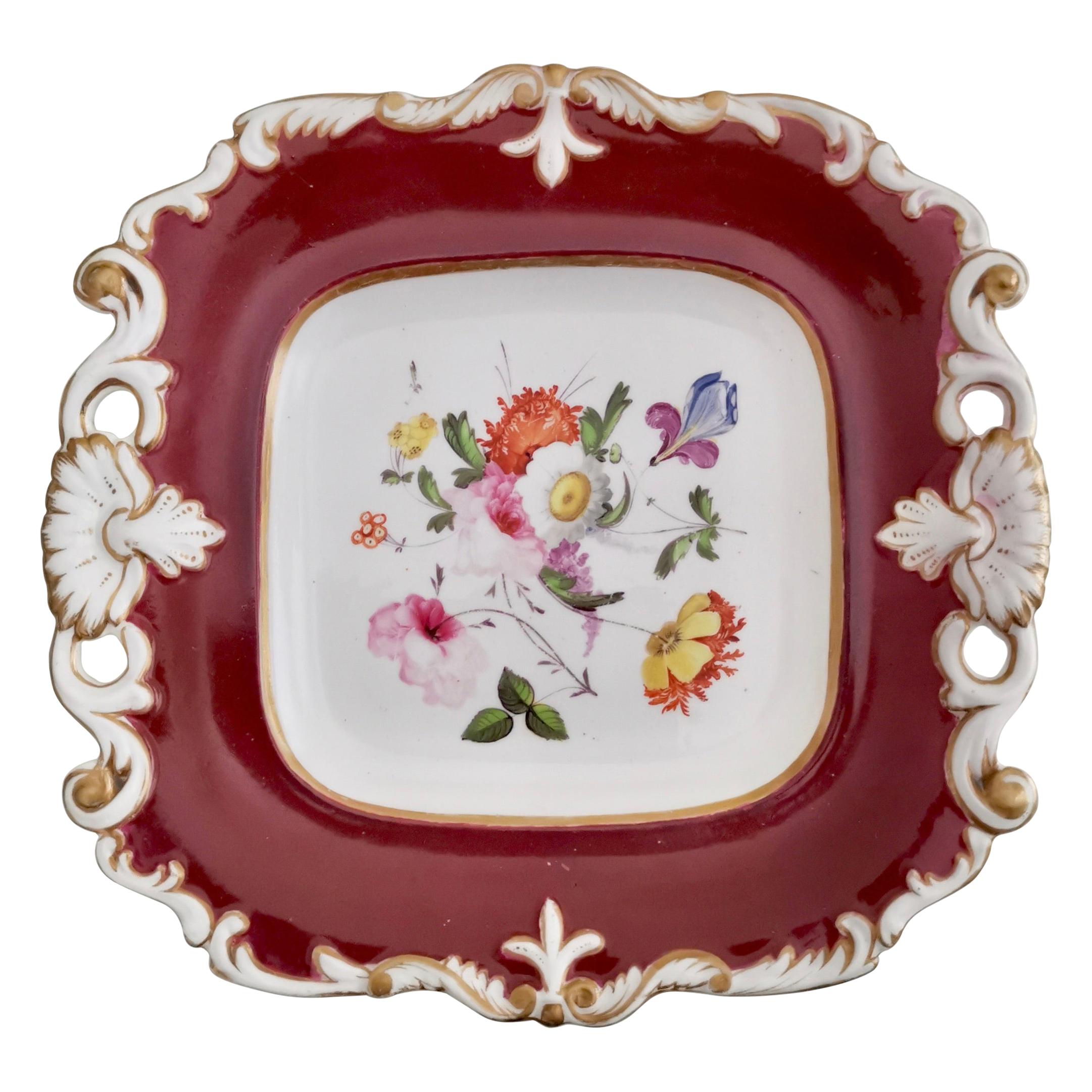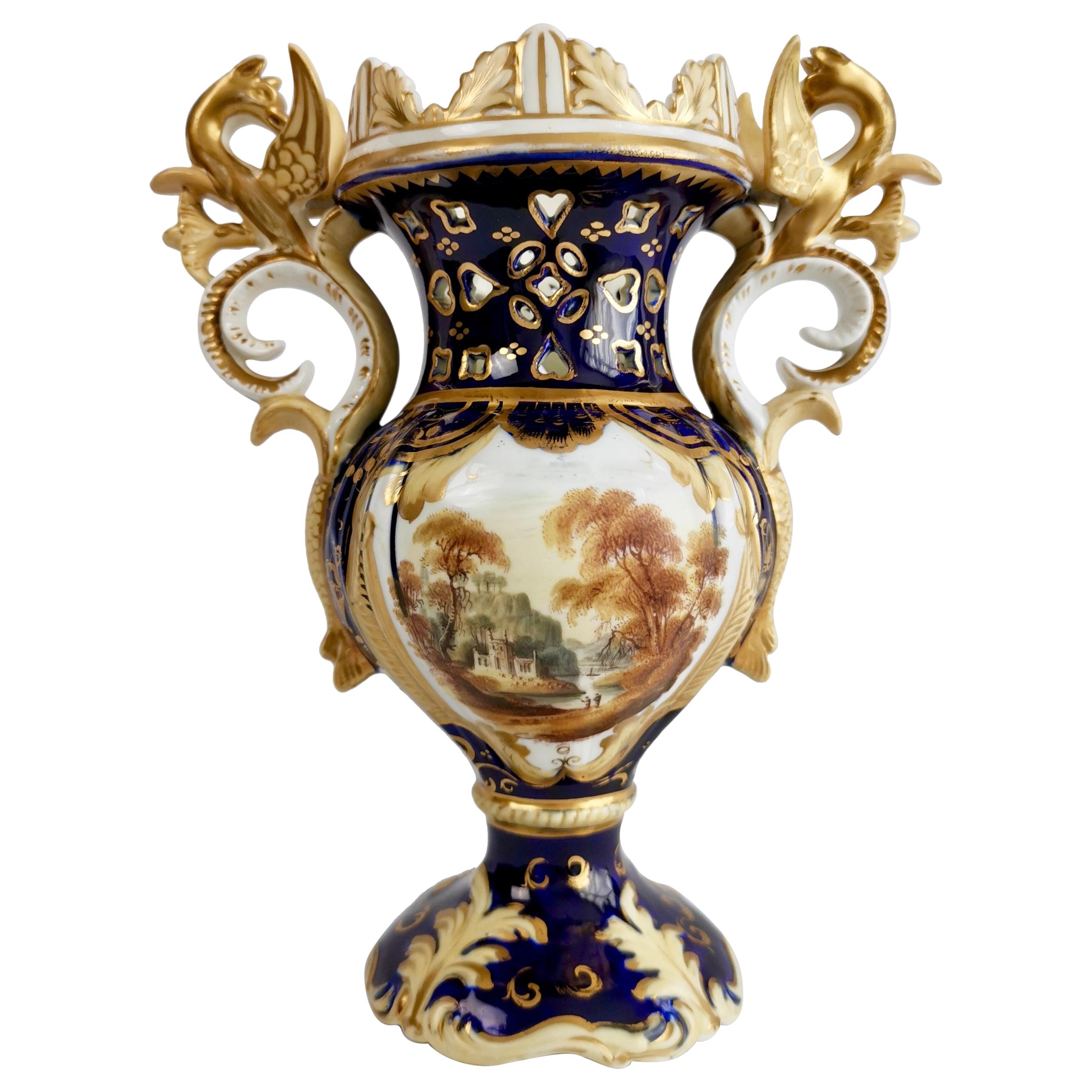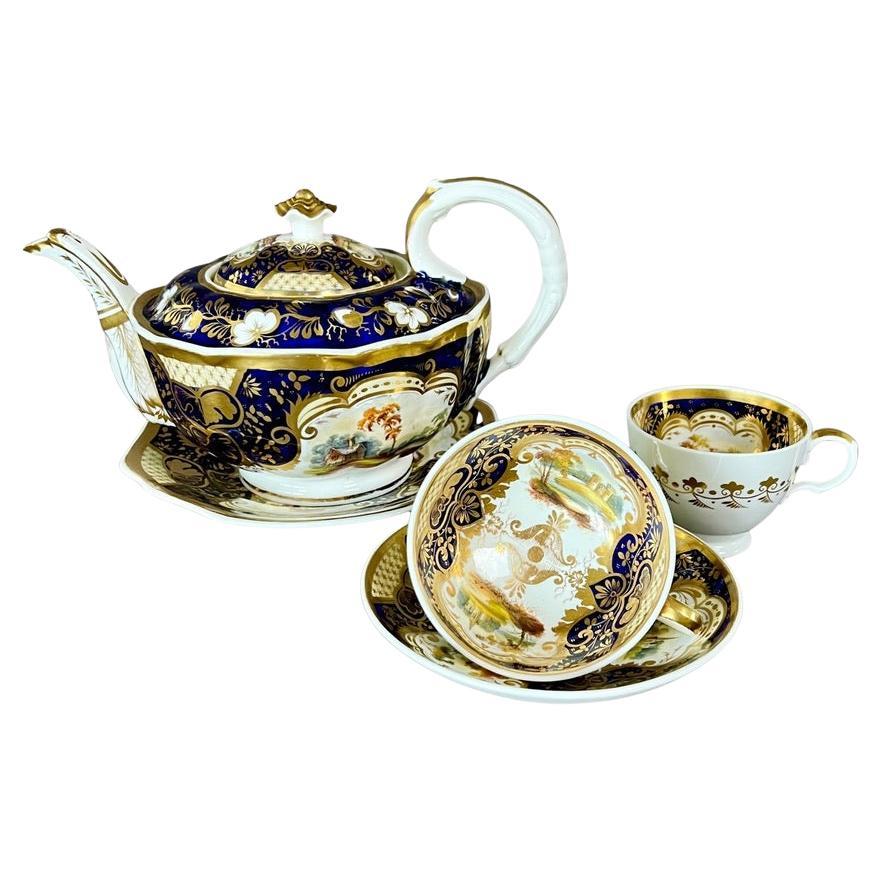Items Similar to Samuel Alcock Vase, Wave-Edge, White with Gilt Chinoiserie Figure, ca 1825
Want more images or videos?
Request additional images or videos from the seller
1 of 16
Samuel Alcock Vase, Wave-Edge, White with Gilt Chinoiserie Figure, ca 1825
About the Item
A very rare wave-edge vase with a gilt Chinoiserie scene of a woman in a garden on a white ground; rich gilding on upper edge, ball and square foot.
Pattern 1035
Year: ca 1825
Size: 19.5cm tall (7.75”)
Condition: stem has been well repaired, some light rubbing and crazing
The Samuel Alcock factory was operative in Staffordshire between 1822 and 1856, after which it was bought by Sir James Duke and Nephews. The factory started as a partnership between the young Samuel Alcock and the older Ralph Stevenson, who provided the factory and capital. Alcock quickly took the factory to great heights, building one of the biggest factories of its time. Alcock jumped on the new Rococo Revival fashion and served a huge new middle class market. The reason we now don't hear much about Samuel Alcock porcelain is that much of it has been mis-identified over the years and attributed to Coalport, Ridgway, Rockingham or others; Alcock did not mark any of his porcelain save a few rare pieces, and the numbering system is difficult to understand. However, the wares are still wide spread and many are of great quality.
This item forms part of the Murray Pollinger Collection of Samuel Alcock Porcelain.
Murray Pollinger was a passionate collector of Samuel Alcock porcelain. He was known as a true gentleman, impeccably dressed, always kind and modest - even some of his porcelain collecting friends had no idea about the size and importance of his collection. From the mid 1980s until shortly before his death in 2022 he collected many thousands of pieces and painstakingly catalogued them. He also went on trips to Staffordshire to discover the history of Samuel Alcock from whatever little documentation has been preserved. Through his painstaking work, Pollinger was able to make sense of the pattern numbering system that was used, and this was a huge step forward in identifying and understanding the porcelain. A website with the results of his research will be made available over the course of 2023. While he sold off about half of his collection in 2016, the remaining half is now made available to a new generation of collectors.
Antique British porcelain is never perfect. Kilns were fired on coal in the 1800s, and this meant that china from that period can have some firing specks from flying particles. British makers were also known for their experimentation, and sometimes this resulted in technically imperfect results. Due to the shrinkage in the kiln, items can have small firing lines or develop crazing over time, which should not be seen as damage but as an imperfection of the maker's recipes, probably unknown at the time of making. Items have often been used for many years and can have normal signs of wear, and gilt can have signs of slight disintegration even if never handled. I will reflect any damage, repairs, obvious stress marks, crazing or heavy wear in the item description but some minor scratches, nicks, stains and gilt disintegration can be normal for vintage items and need to be taken into account.
There is widespread confusion on the internet about the difference between chips and nicks, or hairlines and cracks. I will reflect any damage as truthfully as I can, i.e. a nick is a tiny bit of damage smaller than 1mm and a chip is something you can easily see with the eye; a glazing line is a break in the glazing only; hairline is extremely tight and/or superficial and not picked up by the finger; and a crack is obvious both to the eye and the finger. Etcetera - I try to be as accurate as I can and please feel free to ask questions or request more detailed pictures!
- Creator:Samuel Alcock & Co. (Maker)
- Dimensions:Height: 7.75 in (19.69 cm)Diameter: 3.25 in (8.26 cm)
- Style:Regency (Of the Period)
- Materials and Techniques:
- Place of Origin:
- Period:
- Date of Manufacture:circa 1825
- Condition:Repaired: stem has been well repaired. Wear consistent with age and use. stem has been well repaired, some light rubbing and crazing.
- Seller Location:London, GB
- Reference Number:
About the Seller
5.0
Platinum Seller
These expertly vetted sellers are 1stDibs' most experienced sellers and are rated highest by our customers.
Established in 2016
1stDibs seller since 2019
208 sales on 1stDibs
Typical response time: 1 hour
- ShippingRetrieving quote...Ships From: London, United Kingdom
- Return PolicyA return for this item may be initiated within 14 days of delivery.
More From This SellerView All
- Pair of Samuel Alcock Porcelain Spill Vases, Pink Chinoiserie Figures, ca 1825By Samuel Alcock & Co.Located in London, GBAn extremely rare pair of small porcelain spill vases with a white pearled ring around the body, a bright pink ground and beautiful octagonal reserves with charming Chinoiserie paint...Category
Antique 1820s English Regency Vases
MaterialsPorcelain
- Samuel Alcock Rare Porcelain Vase, Wave Edge, Continuous Fine Landscape, ca 1826By Samuel Alcock & Co.Located in London, GBAn extremely rare wave edge vase on a round foot with superb continuous landscape painting of a river scene with ruins and two figures, rich gilding on the upper edge, ball and foot....Category
Antique 1820s English Regency Vases
MaterialsPorcelain
- Samuel Alcock Porcelain Vase, Maroon with Landscapes, Rococo Revival, ca 1840By Samuel Alcock & Co.Located in London, GBOn offer is a beautiful porcelain vase made by Samuel Alcock circa 1840 during the Rococo Revival era. It has a maroon ground and a stunning landscape painting. Samuel Alcock was on...Category
Antique 1840s English Rococo Revival Vases
MaterialsPorcelain
- Samuel Alcock Porcelain Plate, Maroon with Flowers, Regency, ca 1825By Samuel Alcock & Co.Located in London, GBThis is a very striking and rare dessert plate made by Samuel Alcock around the year 1825. The plate is square and has the "inverted shell" moulding with pierced borders, a deep maro...Category
Antique 1820s English Regency Dinner Plates
MaterialsPorcelain
- Samuel Alcock Griffin Vase, Cobalt Blue with Landscapes, Rococo Revival, ca 1840By Samuel Alcock & Co.Located in London, GBOn offer is a beautiful porcelain vase made by Samuel Alcock in about 1840 during the Rococo Revival era. The vase has griffin-shaped handles, a cobalt blue ground, lavish gilt and a...Category
Antique 1840s English Rococo Revival Vases
MaterialsPorcelain
- Samuel Alcock Porcelain Solitaire Tea Set, Cobalt Blue, Gilt, Landscapes, ca1825By Samuel Alcock & Co.Located in London, GBA solitaire tea set consisting of a teapot with cover on a stand and a trio consisting of a teacup, a coffee cup and a saucer, in “half orange” shape with deep cobalt blue and yellow...Category
Antique 1820s English Regency Tea Sets
MaterialsPorcelain
You May Also Like
- Pair of Empire Gilt Chinoiserie VasesLocated in New York, NYPair of Empire gilt chinoiserie vases. Pair hand-painted and gilt French vases of the Empire period with mask handles and gilt surrounds centering on ...Category
Antique Early 19th Century French Empire Vases
MaterialsPorcelain
- A fine English porcelain Punch Bowl attributed to Samuel Alcock c.1830By Samuel Alcock & Co.Located in Exeter, GBA fine English porcelain Punch Bowl attributed to Samuel Alcock c.1830. Superbly painted summer flowers to the centre interior of the bowl...Category
Antique 19th Century Porcelain
MaterialsPorcelain
- Gilt Chinoiserie CachepotLocated in New York, NYGilt Chinoiserie cachepot. Richly gilt painted porcelain footed planter with scrolled rocaille handles centering front and back charcoal painted orien...Category
Mid-20th Century French Planters, Cachepots and Jardinières
MaterialsPorcelain
- 2 Antique 19th Century English Samuel Alcock Blue Gold Floral Cups & SaucersBy Samuel Alcock & Co.Located in Dayton, OH"Four piece set of antique mid 19th century Samuel Alcock porcelain tea / coffee cups and saucers featuring turquoise blue with florals and gold gilding. Samuel Alcock (1799–1848) was a leading pottery manufacturer who operated as Samuel Alcock & Co in Burslem, Staffordshire from 1828 to 1859. They were especially noted for ""picture jugs"" modelled and moulded in relief in various ceramic materials, a popular type of object in these years. Samuel Alcock & Co. Alcock was born in Kingsley, Staffordshire. He was the youngest of the nine children of Thomas (1746–1816) and Catherine Alcock (1756–1838). Though from a farming background, he developed an interest in commerce after working with his uncle Joseph Locker, a grocer, tea dealer, provision dealer, chandler and banker of the Market Square, Hanley. His introduction to pottery came when he embarked upon a partnership with Ralph Stevenson of Cobridge, Staffordshire. In 1828, Alcock developed his own business and began work on the Hill Top site in Cobridge. By the 1830s Stevenson employed 600 people at his works. In 1839 he completed work on a large factory, built in the Venetian style, on the junction of Westport Road and Greenhead Street. In November of that year a party to celebrate the opening was held at the George Hotel...Category
Antique 19th Century Victorian Tea Sets
MaterialsPorcelain
- Large Italian Chinoiserie VaseLocated in New York, NYLarge Italian chinoiserie vase. Monumental and rare Giovanni Poulard Prad floral and gilt-painted vase with all over floral ground scrolling gilt grape leaf handles centering two dif...Category
Antique Early 19th Century Italian Chinoiserie Vases
MaterialsPorcelain
- Spode Porcelain Beaded Pot Pourri Vase C.1820-1825By Spode FelsparLocated in Exeter, GBA fine Spode Porcelain beaded Pot Pourri vase c.1820-1825. Of flared trumpet shape, embossed with three bands of pearls, resting upon three gilded paw feet, the pierces cover with fl...Category
Antique 19th Century English Porcelain
MaterialsPorcelain
Recently Viewed
View AllMore Ways To Browse
Ceramic Londi
Japanese Brown Ceramic Vase
Blue Glass Vase With Bubbles
Dark Blue Glass Hand Blown
Pate Verre A Walter
Kosta Boda Crystal Vase
Sottsass Jewellery
Tall Wooden Vase
Red Swirl Vase
18th Century Meissen Vase
Gourd Bottle
Wooden Floor Vase
Wabi Sabi Outdoor Table
Vaseline Vase
Kralik Bohemia
Blue Crystal Mobile
St Louis Glassware
Simone Turner
